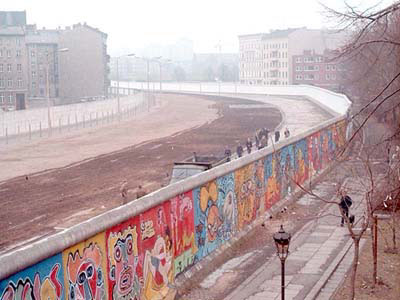 |
usa | world | animals | vocabulary | health | science | math | history |
Iron Curtain
The Iron Curtain is a Western term referring to the boundary which divided Europe into two separate areas of political influence and ideology from the end of World War II until the end of the Cold War.
A variant of the Iron Curtain, the Bamboo Curtain, was coined in reference to the People's Republic of China. As the standoff between the West and the countries of the Iron and Bamboo curtains eased with the end of the Cold War, the term fell out of any but historical usage.
While the Iron Curtain was in place, the countries of Eastern Europe and many in Central Europe (except West Germany, Switzerland and Austria) were under the political influence of the Soviet Union. Indeed the Central European states to the east of the Curtain were frequently regarded as being part of Eastern Europe, rather than Central Europe.
Many of the states were members of the Soviet Union itself (the Soviet Socialist Republics), while with two exceptions the neighboring countries of the Eastern bloc were ruled by pro-Soviet governments, kept in place by the threat of military force. The two exceptions were Yugoslavia which retained its independence, and Albania which escaped Soviet influence in the 1960s and aligned itself with China, though both were ruled by communist ideology and, like the Soviet bloc, operated under a planned economy.
To the east of the Iron Curtain, the states developed their own international economic and military alliances, COMECON and the Warsaw Pact.
To the west of the Iron Curtain, the countries of Western Europe and Southern Europe, along with Austria, West Germany and Switzerland, operated market economies. With the exception of a period of fascism in Spain and Portugal and military dictatorship in Greece, these countries were ruled by democratic governments.
Most states to the West of the Iron the exceptions of neutral Switzerland and Austria, Sweden, Finland and Ireland) were allied with the United States within NATO. Economically the European Community and the European Free Trade Association were the Western counterparts to COMECON.

Berlin Wall, Germany
The term "The Iron Curtain" was first coined by German Chancellor Count Lutz Schwerin von Krosigk in the last days of World War II which he had picked up from Joseph Goebbels anti-Soviet speeches, however it's use was popularized by the former British leader Winston Churchill, who used it in a long speech on March 5, 1946:
"From Stettin in the Baltic to Trieste in the Adriatic an "iron curtain" has descended across the Continent. Behind that line lie all the capitals of the ancient states of Central and Eastern Europe. Warsaw, Berlin, Prague, Vienna, Budapest, Belgrade, Bucharest and Sofia; all these famous cities and the populations around them lie in what I must call the Soviet sphere, and all are subject, in one form or another, not only to Soviet influence but to a very high and in some cases increasing measure of control from Moscow."
Churchill made his speech at Westminster College in Fulton, Missouri. After its fall, a section of the Berlin Wall was transported to and erected at Westminster College. Although the phrase was not well received at the time, as the Cold War strengthened it gained popularity as a short-hand reference to the division of Europe. The Iron Curtain served to keep people in and information out, and the metaphor eventually enjoyed wide acceptance in the West.
In the Soviet Union, the speech was seen by Stalin as reinforcing his view that a future conflict with the West was inevitable. Over the following months, through a mixture of persuasion and purges of those holding contrary views, the Soviet Union did indeed come to see the West as a threat, rather than the ally they had been during World War II. The Cold War had begun in earnest.
The antagonism between the Soviet Union and the West that led to Churchill's speech had various origins.
Britain, France, Japan, Canada, the United States and many other countries had backed the White Russians against the Bolsheviks during the 1918–1920 Russian Civil War, and the fact hadn't been forgotten by the Soviets. In the build up to World War II and in the face of the Western appeasement of Hitler, the Soviets signed the Molotov-Ribbentrop Pact with Nazi Germany, one of the intentions being to divide the border states between them to form a buffer zone. Following the war, Stalin was determined to acquire a similar buffer against the West with pro-Soviet states on its border, leading to strained relations at the Yalta Conference (February 1945) and the subsequent Potsdam Conference (August 1945).
In the West, there was not only opposition to Soviet domination over the buffer states, but the fear grew that the Soviets were building an empire that might be a threat to them and their interests. And, in particular, Churchill was concerned that the United States might return to its pre-war isolationism, leaving the exhausted European states unable to resist Soviet demands. President Franklin D. Roosevelt had announced at Yalta that after the defeat of Germany, US forces would be withdrawn from Europe within two years.